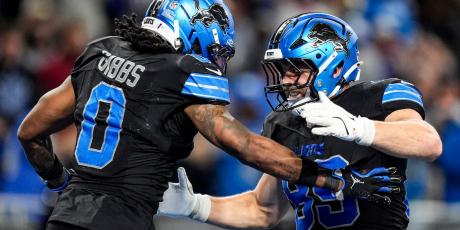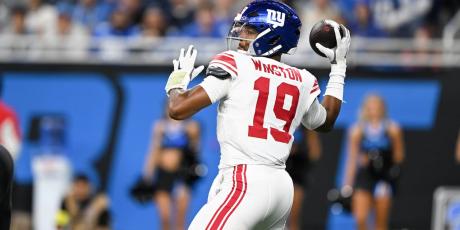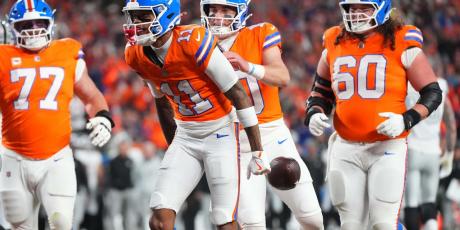NFL Combine Review and Comparisons: Wide Receivers

Didn't the NFL season just end two weeks ago? Yes, but over at 4for4, we are team #NoOffseason. This week, the NFL Combine is going on, and is the first big offseason milestone with fun like free agency, the NFL draft, and much more to come!
There's been criticism of the usefulness of the NFL combine, both from NFL teams and in fantasy circles. Notably, the Los Angeles Rams did not send either head coach Sean McVay or general manager Les Snead to Indianapolis this week. Similarly, Kevin Cole of PFF wrote this article highlighting the impact that individual drills have on a player's fantasy football success in his first several seasons (spoiler alert: it's very small).
More Combine Analysis By Position: RB | TE
But, I still believe that the results we get from the combine can be important...at the extremes. That last part is critical with respect to almost any type of fantasy football analysis, and most certainly the combine. In the context of the combine, players with really poor results (either compared to the rest of the field or relative to expectations) can drag his draft stock down, and vice versa. For example, Henry Ruggs ran a 4.27 40-yard dash in 2018, the fastest time of the combine that year. His expected draft position (via Grinding The Mocks) then rose several spots - which is a lot in the first round - following his performance.
So, throughout this article, I'm going to highlight a couple of players whose results stood out for each position and what to take away from them. This article will go through the wide receiver position, and I will also have articles on the tight end and running back position in the coming days.
Methodology
Before I get into the analysis, I want to explain the methodology and techniques that I used along with delineating what this analysis is and, more importantly, what it is not. Let's start off with the latter.
This analysis is a descriptive way to compare a player's 2022 combine results to historical results. This is not a predictive indicator of future NFL and fantasy success or that a player with a similar combine result will have the same career.
In terms of the methodology, I used a Principal Component Analysis (PCA) using data from the NFL combine since 2000 (keep in mind that there was no combine in 2021), courtesy of Pro Football Reference. If you're unfamiliar with PCA, it is a way to "squish" several variables (in this case, each of our combine metrics), into just a couple variables - our principal components - thus simplifying our dataset and reducing noise. Put another way, PCA helps us find fewer features that will represent our data in a more compressed way.
This also allows me to visualize the results on two axes using the first two principal components, which I wouldn't be able to do easily with the several combine metrics that we have. This is also is where we'll be able to see player comparisons - players that appear further away from the center of the chart are more unique in their results and fall into a more distinct category.
For wide receivers, below are the weights for the combine metrics for each of the two principal components. To calculate a player's principal component, you can read these as linear equations. So for principal component one, a player's score is calculated as (0.50*Broad Jump) + (-0.55*Forty) + (-0.26*Height) + (0.53*Vertical) + (-0.30*Weight).

Player Results
While there were several dozen players who participated in the NFL combine, I'm only going to highlight a couple of players whose performances stood out. You'll see a chart below that shows each of the incoming rookies plotted based on their principal component combine scores.
You'll also notice the different colors used to indicate different clusters of wide receivers based on their combine scores. I did this using a technique called K-Means clustering, and appropriately named the groups based on the features of the wide receivers in each group and their relative combine scores. This is not intended to be a one-size-fits-all grouping for players, but should give you an idea of the types of other receivers that have historically appeared in these groups.

Now, onto the player evaluations!
Tyquan Thornton, Baylor
Holy hell, this man is FAST! Thornton unofficially ran a 4.21 40-yard dash on Thursday night but was later changed to 4.28 officially. Still, he was the fastest wide receiver of the night and brought home a nice chunk of change for 4for4 betting subscribers. He comes in on the lighter side at just 181 pounds, despite being 6' 2", putting his speed score in the 95th percentile.
In his final season at Baylor, Thornton failed to reach 1,000 yards receiving finishing with just 948 yards. However, he did score 10 touchdowns, was the team's clear WR1, and had a very strong 37% dominator rating.
According to Grinding the Mocks, Thornton has yet to be included in a mock draft. But after his performance Thursday night, he will surely garner attention from teams, purely because of his speed.
Similar Combine Scores: Henry Ruggs, Corey Coleman, Mike Wallace
Christian Watson, North Dakota State
Christian Watson had perhaps the best all-around day for receivers on Thursday night. At 6'4" and 208 pounds, Watson ran a 4.36-second 40, the 7th-fastest of the night. He also demonstrated his potential explosiveness with a 136-inch broad jump, which is in the 99th percentile of broad jumps in the 1,000 samples that I used for this study. Watson also was (unofficially) tied with Skyy Moore for the fastest 10-yard splits among receivers.
First round receiver idc idc idc pic.twitter.com/w0iAFdTAJ8
— Brett Kollmann (@BrettKollmann) February 25, 2022
You can see Watson appears at the top-right portion of the chart above, showing that he has speed, size, and burst. Unfortunately, playing for an FCS team in North Dakota State may hurt his case. But, he had a great 18.6 yards per reception and 44% dominator rating in college, which should hopefully offset that. He's becoming one of my favorite prospects as I write this up and think he could make a team very happy this fall.
Similar Combine Scores: DK Metcalf, Julio Jones, Miles Boykin
Wan'Dale Robinson, Kentucky
You want the definition of a slot receiver? Well, let me tell you a bit about Wan'Dale Robinson, who led the receiver class in percent of targets at or behind the line of scrimmage at 33.6% and ran 71.9% of his routes out of the slot, the seventh most in the class.
Robinson came in at a puny (he writes from his desk after struggling to lift a 20-pound weight this morning) 5'8" and 178 pounds. The biggest reason this is a surprise (and not great) is that he was originally listed at 5'11" and 185 pounds. So, while his 4.44 40 time is impressive, it's not that great for his size, and his 34.5-inch vertical and 118-inch broad jump leave a bit to be desired.
Robinson transferred from Nebraska to Kentucky after his sophomore year and is entering the NFL as an early-declare. Robinson is more of a possession receiver that will fit into a specific role for a team, but if he bulks up then could be a Hunter Renfrow or Jamison Crowder-esque threat.
Outside of his size and stature, Robinson has a terrific statistical profile. In his final season, Robinson had a 36% dominator rating, 1,400 scrimmage yards, and was second in the SEC in both receptions and receiving yards. Currently projected as the WR9 taken according to Grinding the Mocks, it will be interesting to see how much teams penalize Robinson for his size.
Similar Combine Scores: Jacoby Ford, Tavon Austin, Dexter McCluster
David Bell, Purdue
Most of the guys I've talked about have been from a positive lens, but David Bell didn't have quite as good of a combine performance. Bell's 4.65-second 40-yard dash was in the 8th percentile of times, which is downright terrible. He couldn't make up for it either with a paltry 33-inch vertical (24th percentile) and 118-inch broad jump (35th percentile). The fact that he has worse numbers than the aforementioned Robinson with an extra five inches and 34 pounds on him is less than ideal.
David Bell’s NFL Career
3/3/22-3/3/22
🪦— Adam Hutchison (@TheRealAdam_H) March 4, 2022
The best thing Bell has going for him is that he's being compared to Davante Adams by everyone. This is mainly a joke, as many think that what he shows on tape outweighs his lackluster profile. Still, he was a solid weapon at Purdue, recording two 1,000-yard seasons in three years and a 30% dominator rating throughout college.
Similar Combine Scores: Jermaine Kearse, Khalil Hill, Kendall Newson

















